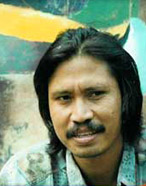 |
||
|---|---|---|
| CP Foundation | About CP Biennale | 2003 | 2005 | Contact Us | >||
           
|
||
|
In his early paintings, Suklu exploited the psychological problems that he had lived through. Suklu, whose mother left when he was a child, was forever obsessed with women. Female figures became the dominating theme in his early paintings. But it is truly intriguing to pay close attention to his later works, particularly since 1997. His narrative paintings have since then gradually dissapeared, and given way to visual art work that showed repetitive forms. Suklu admitted that this attitude had been triggered by the examples set by Ida Pedanda Sidemen Intaran, a leading literary and spiritual figure of Bali, who lived a life of devout meditations. Ida Pedanda Sidemen Intaran counted every piece of the firewood he gathered; counted every swinging sound of his hoe when he worked the land; counted every knit that he made with young coconut leaves prepared for the ceremony. For him, this was a way to make an advantage of his daily activities, using them as a meditation method. The teachings of Ida Pedanda Sidemen Intaran had apparently brought Suklu's awareness to the realms of spiritual meaning and essence. Suklu became obsessed with the power of spiritual energy that were borne out of repetitions. Such awareness became manifest in Suklu's work through explorations of repetitive lines, planes, and colors. Suklu's work that made use of plaiting techniques showed how this repetitive method worked. Suklu realized that his weaving of rattan strips into conical forms was inspired by Ida Pedanda Sidemen Intaran's meditations through repetitive acts. Suklu then went on to create meditational relations through his understanding of the problems of the world. His work, Negeri Anomali (Anomalous Country, 2002/2003) is a depiction of the intricacy caused by the age-old deviations in the universe. The basic form of this work took its root in the structure of a beehive. Suklu made this choice as he believed that this structure also symbolized a house - or a country. Suklu wanted to show the intricacy of the universe through rippings, and even through plantings of mettalic materials in parts of the main area which was made of rattan. All twenty-one conical forms were then hung side by side and connected with each other. Suklu had no desire whatsoever to protest about the destruction or the complexity of the universe. Instead, Suklu merely wished to convey his impression of the universe. Hardiman Born on February 6, 1967 in Klungkung, Bali. SELECTED SOLO EXHIBITIONS SELECTED GROUP EXHIBITIONS |
||
|
CP Foundation | About CP Biennale | 2003 | 2005 | Contact Us
Jl. Suryopranoto 67A, Jakarta 10160, Indonesia. ph. +62.21.3448126, 3853206 | fax. +62.21.3853203, 3853208 info@cp-foundation.org |
||
 I Wayan Sujana Suklu was born and raised among farmers in Klungkung, Bali. While he lived and followed the traditional life in his village, Suklu's childhood was also filled with painting and dancing lessons given by his father. Suklu's father was an undagi, a maker of traditional Balinese houses, who was also a skillful painter and dancer. Suklu then continued to study at the SMSR Denpasar, the fine-art collage in Denpasar, specializing on the traditional painting of Ubud. After working as a relief-maker, Suklu went on to study the visual art at the STSI Denpasar, the fine-art institute at Denpasar. He then graduated and became a lecturer at the institute.
I Wayan Sujana Suklu was born and raised among farmers in Klungkung, Bali. While he lived and followed the traditional life in his village, Suklu's childhood was also filled with painting and dancing lessons given by his father. Suklu's father was an undagi, a maker of traditional Balinese houses, who was also a skillful painter and dancer. Suklu then continued to study at the SMSR Denpasar, the fine-art collage in Denpasar, specializing on the traditional painting of Ubud. After working as a relief-maker, Suklu went on to study the visual art at the STSI Denpasar, the fine-art institute at Denpasar. He then graduated and became a lecturer at the institute.